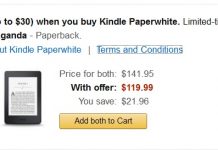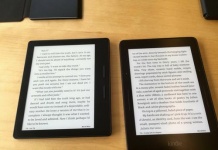A report circulating at the moment, and being extensively quoted, from Consumer Intelligence Research Partners (CIRP), gives the research company’s lowdown on the status of the Kindle market, based on a survey of 300 “US customers of Amazon.com from the three-month period ending November 15, 2013.” Without accurate numbers from Amazon itself, this is one of the most valuable data snapshots of actual Kindle use and spending – and its implications for Amazon and the book business.
 CIRP calculated that the Amazon Kindle platform in the US has “an installed base of approximately 20.5 million units, as of September 30, 2013. Amazon Kindle device owners account for 40% of all Amazon buyers.” Furthermore, said , “we estimate that Amazon Kindle device owners spend approximately $1,233 per year, compared to $790 per year for other customers. They do so because Kindle device owners buy over 50% more frequently than other customers.”
CIRP calculated that the Amazon Kindle platform in the US has “an installed base of approximately 20.5 million units, as of September 30, 2013. Amazon Kindle device owners account for 40% of all Amazon buyers.” Furthermore, said , “we estimate that Amazon Kindle device owners spend approximately $1,233 per year, compared to $790 per year for other customers. They do so because Kindle device owners buy over 50% more frequently than other customers.”
Policies such as Amazon’s newly-announced installment plan for purchase of the Kindle Fire HDX make a great deal more sense in this context. Even at the $379.00 purchase price of the larger size HDX, the Kindle is a machine for minting money for Amazon. For users of the cheaper devices, the metrics are even more in Amazon’s favor – plus, the more expensive multimedia devices will encourage consumption of more expensive content. And critics who brand this kind of pricing as anti-competitive might care to reflect that most mobile phones in the world are sold on carrier contracts with a similar rationale.
With, as Mike Levin, Partner and Co-Founder of CIRP, says, the Kindle acting as “a portal to Amazon.com,” Amazon’s basic business case for creating the Kindle has been comprehensively made. And authors and publishers who produce Kindle/Mobi ebooks can be comfortably reassured that eager readers will be paying out for their wares hand over fist. At 20.5 million units with an average of $1,233 each spent through them, we’re talking about just under $2.53 billion spent by Kindle users on content alone. That should account for quite a few ebook sales.

































I’d regard these numbers with more than a little skepticism. At a high $12 per Kindle item, that $1233/year means buying 100 ebooks or movies a year or about two a week. Those who can afford that level of spending probably don’t have time to read two books a week. And if you substitute a more reasonable $6 an ebook, that becomes four books a week. Do I believe that? No, not in the slightest.
I also make a rule to trust my own personal sampling over that of the so-called experts. Among friends and relatives, buying a Kindle or iPad is accompanied by recouping the investment by finding ways to get ebooks for free or very cheaply, meaning libraries and other online sources like Gutenberg.
Also, in the future, many such people are likely to move to the new, all-you-can-eat online library services such as Oyster ($10/month or $120/year) or perhaps the not-yet-online Nokbok at just $5 a month and with a more sensible business model than Oyster. Those services will attract, first and foremost, the busiest of readers, leaving ‘buy it from Amazon’ for the occasional reader. Why own, spending an outrageous $1233 a year, when you can rent as much as you like and whenever you like for just $60 a year?
This study, particularly its small sample size and dubious numbers, make me suspicious. Does someone who can afford to spend $1233 a year on stuff really need an installment plan for a Kindle Fire? No.
One additional note. I don’t have the time to check out the original, but this article leaves unclear what that $1233 is being spent on. This remark by Teleread makes it sounds like much of that is ebooks: “At 20.5 million units with an average of $1,233 each spent through them, we’re talking about just under $2.53 billion spent by Kindle users on content alone. That should account for quite a few ebook sales.”
But from the rest of the article and based on my own suspicions I am almost certain that is not true. My criticisms are far less relevant if the study simply found that people who buy Kindles from Amazon also buy a lot of other stuff from Amazon, meaning BBQ grills, clothing, and TV sets. That’s not only reasonable, it explains that otherwise inflated $1233 figure much better. Only a more reasonable $100-200 or so of those purchases are likely to be ebooks and movies. That I’d believe.
So, in the end I can’t decide where the spin on this data is coming from, Consumer Intelligence Research or Teleread. But spin it is. Selling a $349 Kindle Fire isn’t resulting in $1233 in Amazon ebook and movie sales each year. That doesn’t come close to passing a smell test.
–Michael W. Perry, Inkling Books
My take on the stats was that it referred to all spending on Amazon, not just on buying Kindle books. Otherwise it makes no sense.
The report is probably bogus. In a related story, CIRP has also claimed that 40% of Amazon customers, or 16.9 million people, are members of one of Amazon’s loyalty programs.
http://www.the-digital-reader.com/2013/12/15/wouldnt-put-much-faith-survey-kindle-owners-spending-amazon/
Yeah, I don’t see how 40% can be both 20.5 million and 16.9 million.